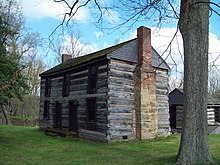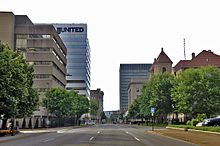Charleston, West Virginia
| Charleston | ||
|---|---|---|
| Nickname : Home of Hospitality, The most northern city of the South and the most southern city of the North, Chemical Valley, The Capitol City, Chucktown, Charly West | ||
 Banks of Charleston on the Kanawha River |
||
 seal |
||
| Location in West Virginia | ||
|
|
||
| Basic data | ||
| Foundation : | 1786 | |
| State : | United States | |
| State : | West Virginia | |
| County : | Kanawha County | |
| Coordinates : | 38 ° 21 ′ N , 81 ° 38 ′ W | |
| Time zone : | Eastern ( UTC − 5 / −4 ) | |
|
Inhabitants : - Metropolitan Area : |
49,138 (as of 2016) 217,916 (as of 2016) |
|
| Population density : | 600 inhabitants per km 2 | |
| Area : | 84.7 km 2 (about 33 mi 2 ) of which 81.9 km 2 (about 32 mi 2 ) is land |
|
| Height : | 182 m | |
| Postcodes : | 25301-25396 | |
| Area code : | +1 304 | |
| FIPS : | 54-14600 | |
| GNIS ID : | 1558347 | |
| Website : | www.cityofcharleston.org | |
| Mayor : | Danny Jones (R) | |
 The Elk River near its mouth in Charleston |
||
Charleston has been the capital of West Virginia , the 35th state of the United States , since 1885 . The city is located at the confluence of the Elk River with the Kanawha River . Charleston is the largest city in West Virginia.
history
The beginnings
After the American Revolutionary War , pioneers slowly moved from existing settlements to western Virginia , now West Virginia. The area around what is now Charleston was of particular importance because of its many mineral resources and raw materials. The town's history began when the Bullitt family received 505 acres of land at the mouth of the Elk River in 1774. In 1786 this land was sold to Colonel George Clendenin, who with his Virginia Rangers built Fort Lee, the first permanent settlement in this area. Six years later, Charleston was founded, which was named after Clendenin's father Charles. In 1794, 35 people lived in seven houses on an area of 16 hectares.
Industrial growth
At the beginning of the 19th century, salt deposits were discovered along the Kanawha River and quickly developed; In 1808, 1,250 pounds of salt were mined daily. Soon the Kanawha Salines near Charleston became the largest salt producer in the world. When Captain James Wilson was drilling for salt in 1815, he came across a large natural gas deposit. In 1817 coal was discovered, which initially only served as an energy source for salt production. After 1861, the importance of the salt industry in Kanawha decreased.
Political development
Charleston grew rapidly until the beginning of the Civil War in 1861. In the Civil War, Virginia split from the Northern States (Union). The city of Charleston was politically divided between supporters of the Union and the southern states (Confederation) . On September 13, 1862, the troops of the Confederation won the Battle of Charleston , but were only able to keep the city briefly occupied. The Union Army retook Charleston six weeks later and held control of the city and much of western Virginia until the end of the war. On June 20, 1863, President Abraham Lincoln declared the return of the Union-occupied northwestern part of Virginia to the United States. Under the name West Virginia, this region became the 35th state in the United States. Slavery is often given as the reason for the split, but the motive was probably more of an economic nature. The industry in the north of the United States, particularly the steel industry in Ohio , depended on coal supplies from West Virginia's mines. This establishes the United States' strong military engagement in the region. Already at the beginning of the Civil War, massive troops were relocated from Ohio to the coal regions of Virginia in order to ensure the supply of coal.
For a number of years the young new state of West Virginia could not agree on a capital city. So Wheeling and Charleston initially alternated in this role. It was not until 1877 that a referendum made Charleston the only capital.
Urban development
The first capitol was opened in 1895. After a devastating fire in 1921, a second capitol was built, which again burned down in 1927. Subsequently, it was decided to build a capitol in the Italian Renaissance style with a gilded dome of 90 meters high, which was inaugurated on June 20, 1932.
The city had its largest population of around 86,000 in the 1960s. Since then, population decline has caused entire neighborhoods to decline. Urban revitalization programs have been running since the 1980s, through which several shopping centers and the Clay Center, a cultural and educational center, were built.
Population development
| year | Residents |
|---|---|
| 1900 | 11,099 |
| 1920 | 39,608 |
| 1960 | 85,796 |
| 1980 | 63,968 |
| 1990 | 57,287 |
| 2000 | 53,421 |
| 2010 | 51,400 |
| 2016 | 49,138 |
The metropolitan area of Charleston (the Charleston Metropolitan Statistical Area ) comprises the counties Kanawha , Boone and Clay and had about 240,000 inhabitants in 2011, of which about 93 percent were white and 5 percent were African-American .
Location and climate
Charleston is quite central in the state on the Kanawha River , an hour's drive from Parkersburg , Huntington and Beckley , with easy access to the three interstate highways I-64 , I-77 and I-79 that cross the state.
| Charleston, West Virginia | ||||||||||||||||||||||||||||||||||||||||||||||||
|---|---|---|---|---|---|---|---|---|---|---|---|---|---|---|---|---|---|---|---|---|---|---|---|---|---|---|---|---|---|---|---|---|---|---|---|---|---|---|---|---|---|---|---|---|---|---|---|---|
| Climate diagram | ||||||||||||||||||||||||||||||||||||||||||||||||
| ||||||||||||||||||||||||||||||||||||||||||||||||
|
Average monthly temperatures and rainfall for Charleston, West Virginia
|
|||||||||||||||||||||||||||||||||||||||||||||||||||||||||||||||||||||||||||||||||||||||||||||||||||||||||
economy
The economy of Charleston is characterized by industry, especially the chemical industry ( DuPont de Nemours , Union Carbide ) with a Science Park and glass industry . In addition to the electricity industry (Appalachian Power) , printing plants and tourism play a role.

Attractions
- West Virginia State Capitol (89 yards)
- Capital Market
- Town Center Mall and Civic Center
- Clay Center (cultural and educational center) with the Sunrise Museum (natural science museum)
- East End Historical District
- Kanawha State Forest
- Kanawha River
- Downtown

The National Park Service lists 52 buildings and sites for Charleston in the National Register of Historic Places (NRHP) (as of November 14, 2018).
Name variants
The city has a few different names:
- Charles Town
- Charleston-on-the-Kanawha
- Charlestown
- Clendenin's Settlement
- Clendenin's Fort
- Clendenin's Settlement
- Fort Clendennin
- Fort Lee
- Kanawha
- Kanawha Court House
- Mouth of Elk
- The Town at the Mouth of Elk
Others
- Seat of a Methodist and an Anglican bishop
- Charleston University , Conservatory and Art School
- Airport "Yeager-Airport", IATA airport code CRW
Town twinning
Banská Bystrica in Slovakia has been a twin town of Charleston since 2010 .
sons and daughters of the town
- George W. Atkinson (1845–1925), 10th Governor of West Virginia
- Lewis Lichtenstein Strauss (1896–1974), politician and chairman of the Atomic Energy Agency
- Tommy Benford (1905–1994), jazz musician, representative of traditional jazz
- Earl Songer (1916–1972), country musician
- John Weakland (1919–1995), chemist, anthropologist and co-founder of the Palo Alto Group
- Douglas Dick (1920–2015), actor, screenwriter, later psychiatrist
- George A. Miller (1920–2012), psychologist and professor at Princeton University
- Leon Sullivan (1922–2001), Baptist pastor and civil rights activist
- Thomas Jonathan Jackson Altizer (1927–2018), religious scholar
- Robert Drasnin (1927–2015), composer and conductor
- George Crumb (* 1929), composer
- Allison Hayes (1930–1977), film actress and photo model
- Sara Jane Moore (* 1930) tried to assassinate President Gerald Ford
- Iris Bell (1934-2008), musician
- Rod Hundley (1934-2015), basketball player and radio commentator
- Robert Nugent Lynch (* 1941), Roman Catholic clergyman, bishop emeritus of Saint Petersburg
- Conchata Ferrell (born 1943), actress
- Daniel Webster (* 1949), politician
- Carolyn Gordon (born 1950), mathematician
- Ann Magnuson (born 1956), actress and singer
- Randy Barnes (* 1966), shot putter, Olympic champion in 1996 and current world record holder
- William Frischkorn (* 1981), racing cyclist
Individual evidence
- ↑ 1900–2000: Census Results
- ↑ US Census Bureau - American FactFinder
- ↑ West Virginia (USA): State, Cities & Towns - Population Statistics, Maps, Charts, Weather, and Web Information. Retrieved February 7, 2018 .
- ↑ Search mask database in the National Register Information System. National Park Service , accessed November 14, 2018.
- ↑ a b c d e f Kenny, Hamill. West Virginia Place Names. Piedmont, West Virginia: The Place Name Press, 1945. The origin and meaning, including the nomenclature of the streams and mountains. p164
- ^ The American Guide Series, Compiled and Written by the Federal Writers' Project of the Work Projects Administration. A state by state guide series published by various publishers, in the late 1930's and 1940's. Each book studies and describes each state's history, natural endowments, and special interests. Use code US-T125 / Name / YYYY / p #. West Virginia / p180
- ↑ Wintz, William D. and Ivan N. Hunter. (eds). The History of Putnam County. Charleston, West Virginia: Quick Copy Service, 1967. p10
- ^ Bishop, William H. History of Roane County West Virginia: From The Time of Its Exploration to AD 1927. Spencer, West Virginia: np, 1927 p47
- ↑ Kenny, Hamill. West Virginia Place Names. Piedmont, West Virginia: The Place Name Press, 1945. The origin and meaning, including the nomenclature of the streams and mountains. p56
- ^ US Post Office Site Location Report, 1837-1950, available in microfilm, use code US-T140 / # - # of roll. 643
- ^ Bishop, William H. History of Roane County West Virginia: From The Time of Its Exploration to AD 1927. Spencer, West Virginia: np, 1927 p53




